
Haworthia is a large genus of small succulent plants endemic to Southern Africa (Mozambique, Namibia, Lesotho, Eswatini and South Africa).

Cotyledon is one of some 35 genera of succulent plants in the family Crassulaceae. Mostly from Southern Africa, they also occur throughout the drier parts of Africa as far north as the Arabian Peninsula. Ten of its species are mostly confined to South Africa, where unlike Tylecodon, they occur commonly in both the winter and summer rainfall regions. They may be found on coastal flats and rocky hillsides, or as cremnophytes on cliff faces. Their decussate, evergreen leaves are very variable in shape, even within some species, but the flowers are, apart from colour, very similar.
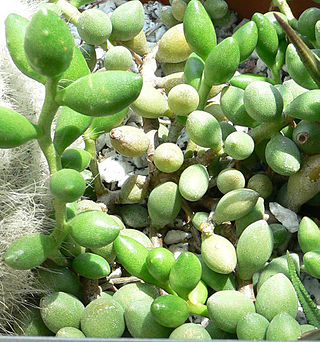
Adromischus is a genus of flowering plants. They are easily-propagated, leaf succulents from the family Crassulaceae, which are endemic to southern Africa. The name comes from the ancient Greek adros (=thick) and mischos (=stem).

Cotyledon tomentosa is a species of flowering plant in the family Crassulaceae, native to South Africa. It is a succulent evergreen shrub with large chunky ovate fuzzy green leaves. Its autonymous subspecies is known as the bear's paw because of the prominent "teeth" at the tips of its leaves. It forms large orange bell-shaped flowers in spring. In its native habitat, the Little Karoo region of South Africa, Cotyledons usually grow in rocky quartz fields where they have excellent drainage provided by very porous soil.

Astroloba spiralis is a small succulent plant of the Astroloba genus, endemic to the southern Karoo regions of the Western and Eastern Cape Provinces, South Africa.
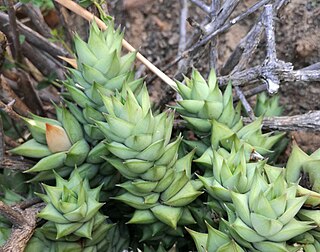
Astroloba herrei is a small succulent plant of the genus Astroloba, restricted to the area around the Swartberg mountains, South Africa.

Astroloba foliolosa is a small succulent plant of the genus Astroloba widespread in the arid parts of the Eastern Cape Province, South Africa.

Adromischus cooperi is a species of succulent plant from the family Crassulaceae. The genus name Adromischus comes from ancient Greek adros and mischos, and the species name from Thomas Cooper. The plant is endemic to the Eastern Cape of South Africa.

Crassula biplanata is a succulent plant native to rocky ledges and mountainous areas in the southern parts of South Africa.
Pteronia glauca ("Geelboegoekaroo") is a species of flowering plant in the family Asteraceae, indigenous to the Karoo regions of South Africa.
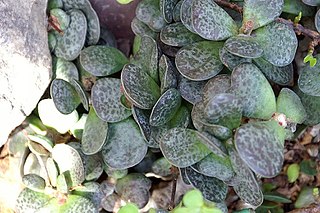
Adromischus maculatus, the spotted adromischus or calico hearts, is a species of flowering plant in the family Crassulaceae, which is endemic to the Eastern Cape and Western Cape of South Africa.
Acrodon deminutus, also known as the Malgas tiptoothfig, is a species of mesemb from South Africa.

Cheiridopsis speciosa is a species of plant from South Africa.
Cheiridopsis schlechteri is a species of plant from South Africa. It is a succulent plant that grows in dry habitats.
Cheiridopsis purpurea is a species of succulent plant from South Africa. It is found growing in the succulent Karoo vegetation type.
Cheiridopsis ponderosa is a species of succulent plant from South Africa.
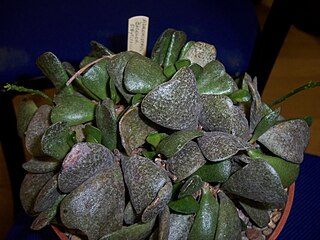
Adromischus bicolor is a perennial, succulent plant in the family Crassulaceae. The species name bicolor refers to the light, grey-green leaves spotted with purple to purple-green spots. It is endemic to the Succulent Karoo of western South Africa, as well as the Eastern Cape, South Africa.
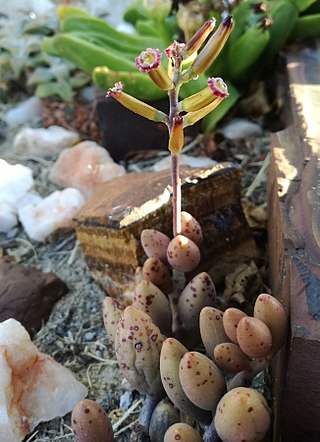
Adromischus filicaulis is a perennial, succulent plant in the family Crassulaceae. It is commonly called brosplakkies in Afrikaans. The species is endemic to South Africa and Namibia.
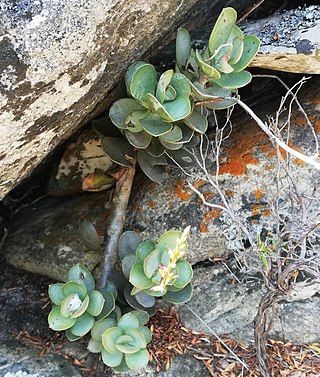
Adromischus hemisphaericus is a perennial, succulent plant in the Crassulaceae family. It is commonly called Brosplakkies. The species is endemic to the Western Cape, South Africa.
















